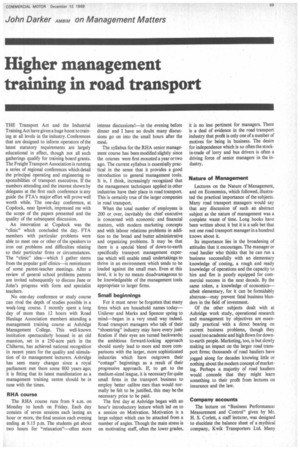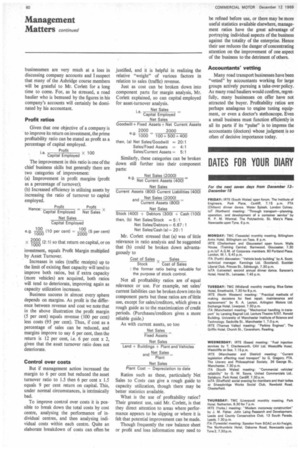Higher management training in road transport
Page 97

Page 98

If you've noticed an error in this article please click here to report it so we can fix it.
THE Transport Act and the Industrial Training Act have given a huge boost to training at all levels in the industry. Conferences that are designed to inform operators of the latest statutory requirements are largely educational in effect, though not all such gatherings qualify for training board grants. The Freight Transport Association is running a series of regional conferences which detail the principal operating and engineering responsibilities of transport executives. If the numbers attending and the interest shown by delegates at the first such conference is any guide the FTA's major effort will prove well worth while. The one-day conference, at Copdock, near Ipswich, impressed me with the scope of the papers presented and the quality of the subsequent discussion.
An innovation at Copdock was the "clinic" which concluded the day. FTA members with particular problems were able to meet one or other of the speakers to iron out problems and difficulties relating to their particular firms or circumstances. The "clinic" idea—which I gather stems from the popular golf clinics—is reminiscent of some parent-teacher meetings. After a review of general school problems parents are invited subsequently to discuss Jane or John's progress with form and specialist teachers.
No one-day conference or study course can rival the depth of studies possible in a week-long course. I recently spent a long day of more than 12 hours with Road Haulage Association members attending a management training course at Ashridge Management College. This well-known institution spectacularly housed in an old mansion, set in a 250-acre park in the Chilterns, has achieved national recognition in recent years for the quality and stimulation of its management lecturers. Ashridge has seen many changes since a royal parliament met there some 800 years ago; it is fitting that its latest manifestation as a management training centre should be in tune with the times.
R HA course The RHA course runs from 9 a.m. on Monday to lunch on Friday. Each day consists of seven sessions each lasting an hour or more, the final session each evening ending at 9.15 p.m. The students get about two hours for "relaxation"—often more intense discussions!—in the evening before dinner and I have no doubt many discussions go on into the small hours after the meal.
The syllabus for the RHA senior management course has been modified slightly since the courses were first mounted a year Or two ago. The current syllabus is essentially practical in the sense that it provides a good introduction to general management tools. It is, I think, increasingly recognized that the management techniques applied in other industries have their place in road transport. This is certainly true of the larger companies in road transport.
When the total number of employees is 200 or over, inevitably the chief executive is concerned with economic and financial matters, with modern marketing concepts and with labour relations problems in addition to the bread and butter administrative and organizing problems. It may be that there is a special blend of down-to-earth specifically transport management expertise which will enable small undertakings to thrive in an environment which tends to be loaded against the small man. Even at this level, it is by no means disadvantageous to be knowledgeable of the management tools appropriate to larger firms.
Small beginnings For it must never be forgotten that many firms which are household names today— Unilever and Marks and Spencer spring to mind—began in a very small way indeed. Road transport managers who talk of their "shoestring" industry may have every justification if their eyes are turned backwards; the ambitious forward-looking approach should surely lead to more and more comparisons with the larger, more sophisticated industries which have outgrown their "cottage" beginnings as a result of their progressive approach. If, to get to the medium-sized league, it is necessary for quite small firms in the transport business to employ better calibre men than would normally be felt to be justified, this may be the necessary price to be paid.
The first day at Ashridge began with an hour's introductory lecture which led on to a session on Motivation. Motivation is a large subject which can be attacked from a number of angles. Though the main stress is on motivating staff, often the lower grades, it is no less pertinent for managers. There is a deal of evidence in the road transport industry that profit is only one of a number of motives for being in business. The desire for independence which is so often the stockin-trade of lorry and bus drivers is often a driving force of senior managers in the industry.
Nature of Management Lectures on the Nature of Management, and on Economics, which followed, illustrated the practical importance of the subjects. Many road transport managers would say that any discussion of such an abstract subject as the nature of management was a complete waste of time. Long books have been written about it but it is a safe bet that not one road transport manager in a hundred knows about it.
Its importance lies in the broadening of attitudes that it encourages. The manager or road haulier who thinks that he can run a business successfully with an elementary knowledge of costing, a rough and ready knowledge of operations and the capacity to hire and fire is poorly equipped for commercial success in the next decade. By the same token, a knowledge of economics— albeit elementary, for it can be formidably abstruse—may prevent fatal business blunders in the field of investment.
Of the other subjects dealt with at Ashridge work study, operational research and management by objectives are essentially practical with a direct bearing on current business problems, though they sound too academic and high flown for downto-earth people. Marketing, too, is but slowly making an impact on the larger road transport firms; thousands of road hauliers have jogged along for decades knowing little or nothing about the modern concept of marketing. Perhaps a. majority of road hauliers would concede that they might learn something to their profit from lectures on insurance and the law.
Company accounts The lecture on "Business Performance: Measurement and Control" given by Mr. H. S. Corlett, a staff lecturer, was designed to elucidate the balance sheet of a mythical company, Kwik Transporters Ltd. Many businessmen are very much at a loss in discussing company accounts and I suspect that many of the Ashridge course members will be grateful to Mr. Corlett for a long time to come. For, as he stressed, a road haulier who is bemused by the figures in his company's accounts will certainly be dominated by his accountant.
Profit ratios Given that one objective of a company is to improve its return on investment, the prime profitability ratio can be stated as profit as a percentage of capital employed.
Profit
e. X 100 Capital Employed
The improvement in this ratio is one of the chief business skills hut generally there are two categories of improvement:
(a) Improvement in profit margins (profit as a percentage of turnover); (b) Increased efficiency in utilizing assets by increasing the ratio of turnover to capital employed.
e.g. (10 per cent) – 2000 (5 per cent)
2000
x — (2:1) so that return on capital, or on 1000
investment, equals Profit Margin multiplied by Asset Turnover.
Increases in sales (traffic receipts) up to the limit of existing fleet capacity will tend to improve both ratios, but if extra capacity (more vehicles) are acquired, both ratios will tend to deteriorate, improving again as capacity utilization increases.
Business success in almost every sphere depends on margins. As profit is the difference between revenue and cost we note that in the above illustration the profit margin (5 per cent) equals revenue (100 per cent) less costs (95 per cent). Thus, if cost as a percentage of sales can be reduced, and margins improve to say 6 per cent, then the return is 12 per cent, i.e. 6 per cent x 2, given that the asset turnover ratio does not deteriorate.
Control over costs But if management action increased the margin to 6 per cent but reduced the asset turnover ratio to 1.5 then 6 per cent x 1.5 equals 9 per cent return on capital. This, under normal circumstances, is intrinsically bad.
To improve control over costs it is possible to break down the total costs by cost centre, analysing the performance of individual centres, and then analysing individual costs within each centre. Quite an elaborate breakdown of costs can often be
justified, and it is helpful in realizing the relative "weight" of various factors in relation to sales (traffic) revenue.
Just as cost can be broken down into component parts for margin analysis, Mr. Corlett explained, so can capital employed for asset-turnover analysis.
Not all profitability ratios are of equal relevance or use. For example, net sales/ current liabilities can be broken down into its component parts but these ratios are of little use, except for sales/creditors, which gives a rough guide as to the maximization of credit periods. (Purchases/creditors gives a more reliable guide.) As with current assets, so too Ratios such as these, particularly Net Sales to Costs can give a rough guide to capacity utilization, though there may be better statistics available.
What is the use of profitability ratios? Their greatest use, said Mr. Corlett, is that they direct attention to areas where performance appears to be slipping or where it is felt that potential improvement can be made.
Though frequently the raw balance sheet or profit and loss information may need to be refined before use, or there may be more useful statistics available elsewhere, management ratios have the great advantage of portraying individual aspects of the business against the totality of the enterprise. Hence their use reduces the danger of concentrating attention on the improvement of one aspect of the business to the detriment of others.
Accountants' vetting Many road transport businesses have been "vetted" by accountants working for large groups actively pursuing a take-over policy. As many road hauliers would confirm, regretfully, many businesses on offer have not attracted the buyer. Profitability ratios are perhaps analagous to engine tuning equipment, or even a doctor's stethoscope. Even a small business must function efficiently in all its parts if its "pulse" is to impress the accountants (doctors) whose judgment is so often of decisive importance today.
























































































































































